Competitive Strategy Essay: Key Strategy Development Tools Analysis
VerifiedAdded on 2022/10/02
|9
|2078
|22
Essay
AI Summary
This essay provides a comprehensive overview of key strategy development tools used in business, focusing on PESTLE analysis, Porter's Five Forces model, and SWOT analysis. The essay begins by introducing the importance of strategic analysis in understanding the business environment and makin...
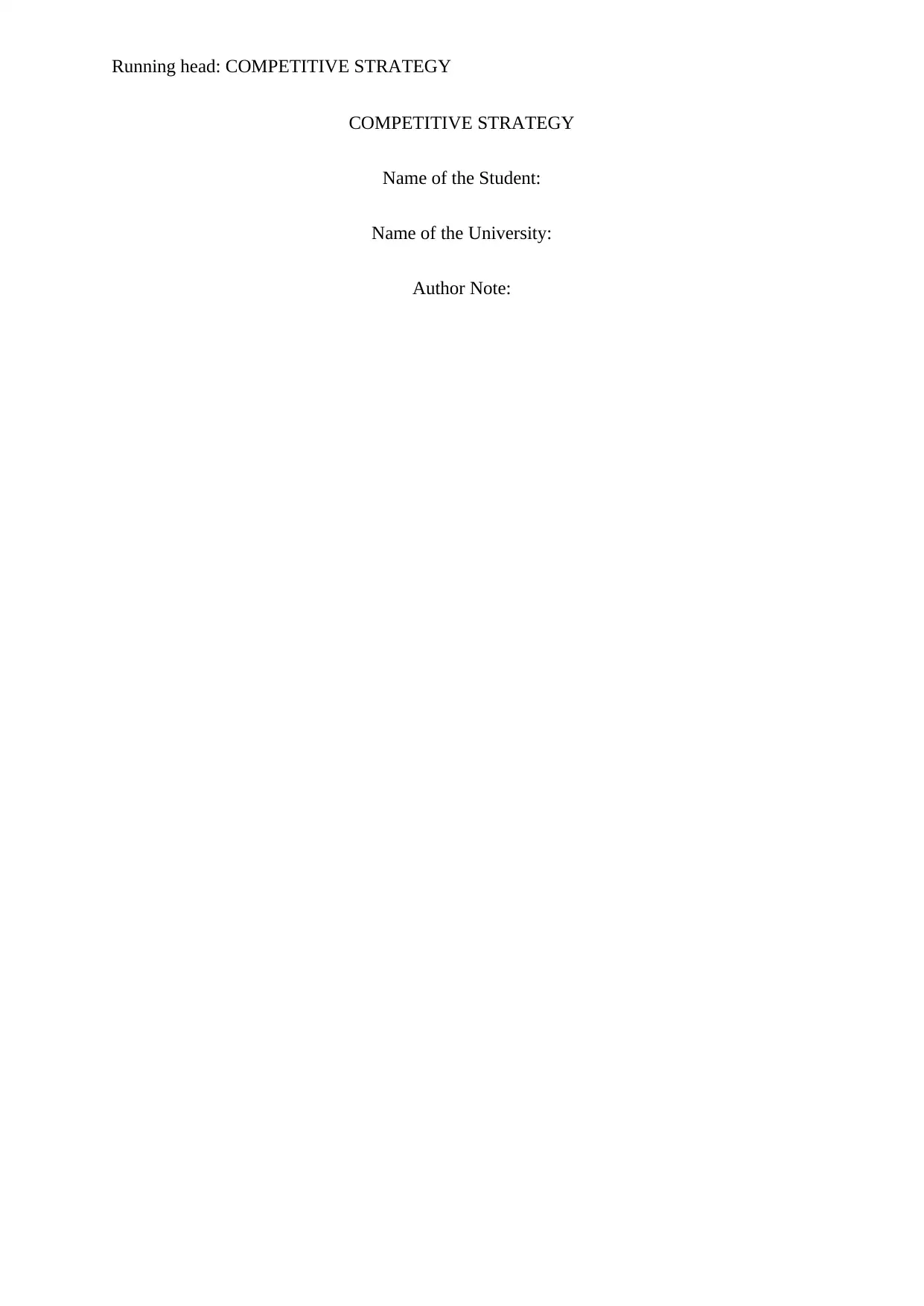
Running head: COMPETITIVE STRATEGY
COMPETITIVE STRATEGY
Name of the Student:
Name of the University:
Author Note:
COMPETITIVE STRATEGY
Name of the Student:
Name of the University:
Author Note:
Paraphrase This Document
Need a fresh take? Get an instant paraphrase of this document with our AI Paraphraser
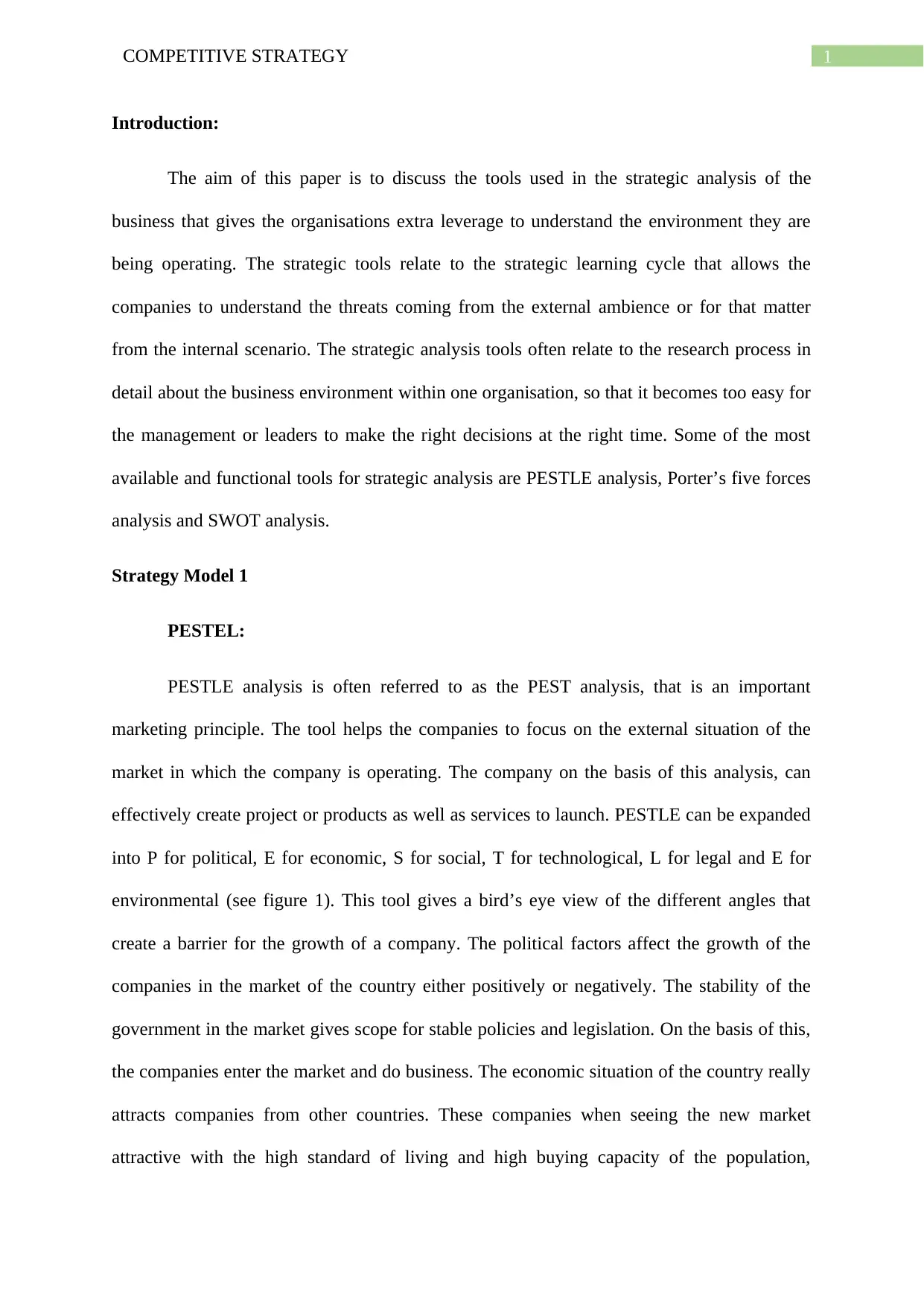
1COMPETITIVE STRATEGY
Introduction:
The aim of this paper is to discuss the tools used in the strategic analysis of the
business that gives the organisations extra leverage to understand the environment they are
being operating. The strategic tools relate to the strategic learning cycle that allows the
companies to understand the threats coming from the external ambience or for that matter
from the internal scenario. The strategic analysis tools often relate to the research process in
detail about the business environment within one organisation, so that it becomes too easy for
the management or leaders to make the right decisions at the right time. Some of the most
available and functional tools for strategic analysis are PESTLE analysis, Porter’s five forces
analysis and SWOT analysis.
Strategy Model 1
PESTEL:
PESTLE analysis is often referred to as the PEST analysis, that is an important
marketing principle. The tool helps the companies to focus on the external situation of the
market in which the company is operating. The company on the basis of this analysis, can
effectively create project or products as well as services to launch. PESTLE can be expanded
into P for political, E for economic, S for social, T for technological, L for legal and E for
environmental (see figure 1). This tool gives a bird’s eye view of the different angles that
create a barrier for the growth of a company. The political factors affect the growth of the
companies in the market of the country either positively or negatively. The stability of the
government in the market gives scope for stable policies and legislation. On the basis of this,
the companies enter the market and do business. The economic situation of the country really
attracts companies from other countries. These companies when seeing the new market
attractive with the high standard of living and high buying capacity of the population,
Introduction:
The aim of this paper is to discuss the tools used in the strategic analysis of the
business that gives the organisations extra leverage to understand the environment they are
being operating. The strategic tools relate to the strategic learning cycle that allows the
companies to understand the threats coming from the external ambience or for that matter
from the internal scenario. The strategic analysis tools often relate to the research process in
detail about the business environment within one organisation, so that it becomes too easy for
the management or leaders to make the right decisions at the right time. Some of the most
available and functional tools for strategic analysis are PESTLE analysis, Porter’s five forces
analysis and SWOT analysis.
Strategy Model 1
PESTEL:
PESTLE analysis is often referred to as the PEST analysis, that is an important
marketing principle. The tool helps the companies to focus on the external situation of the
market in which the company is operating. The company on the basis of this analysis, can
effectively create project or products as well as services to launch. PESTLE can be expanded
into P for political, E for economic, S for social, T for technological, L for legal and E for
environmental (see figure 1). This tool gives a bird’s eye view of the different angles that
create a barrier for the growth of a company. The political factors affect the growth of the
companies in the market of the country either positively or negatively. The stability of the
government in the market gives scope for stable policies and legislation. On the basis of this,
the companies enter the market and do business. The economic situation of the country really
attracts companies from other countries. These companies when seeing the new market
attractive with the high standard of living and high buying capacity of the population,
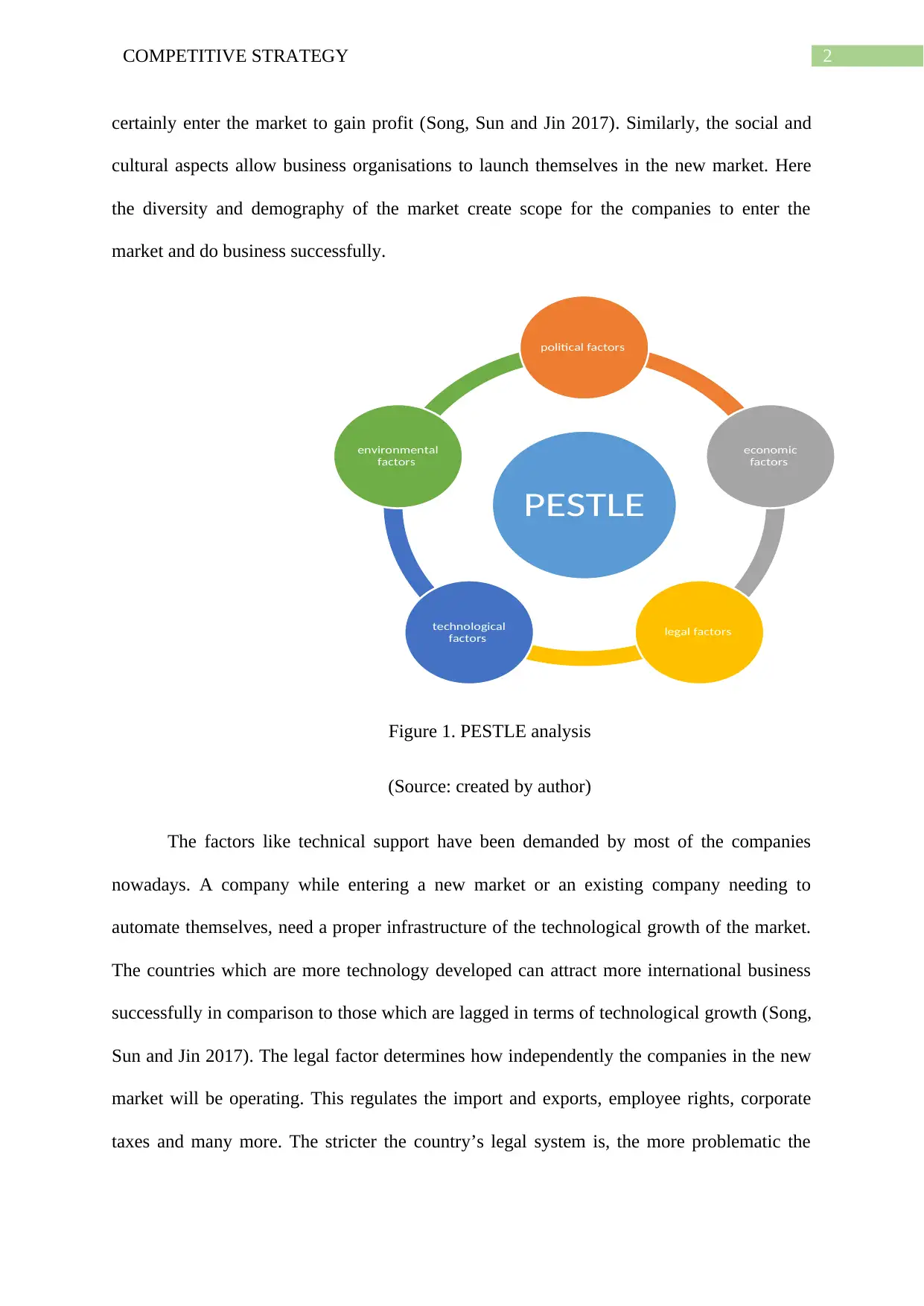
2COMPETITIVE STRATEGY
certainly enter the market to gain profit (Song, Sun and Jin 2017). Similarly, the social and
cultural aspects allow business organisations to launch themselves in the new market. Here
the diversity and demography of the market create scope for the companies to enter the
market and do business successfully.
Figure 1. PESTLE analysis
(Source: created by author)
The factors like technical support have been demanded by most of the companies
nowadays. A company while entering a new market or an existing company needing to
automate themselves, need a proper infrastructure of the technological growth of the market.
The countries which are more technology developed can attract more international business
successfully in comparison to those which are lagged in terms of technological growth (Song,
Sun and Jin 2017). The legal factor determines how independently the companies in the new
market will be operating. This regulates the import and exports, employee rights, corporate
taxes and many more. The stricter the country’s legal system is, the more problematic the
PESTLE
political factors
economic
factors
legal factors
technological
factors
environmental
factors
certainly enter the market to gain profit (Song, Sun and Jin 2017). Similarly, the social and
cultural aspects allow business organisations to launch themselves in the new market. Here
the diversity and demography of the market create scope for the companies to enter the
market and do business successfully.
Figure 1. PESTLE analysis
(Source: created by author)
The factors like technical support have been demanded by most of the companies
nowadays. A company while entering a new market or an existing company needing to
automate themselves, need a proper infrastructure of the technological growth of the market.
The countries which are more technology developed can attract more international business
successfully in comparison to those which are lagged in terms of technological growth (Song,
Sun and Jin 2017). The legal factor determines how independently the companies in the new
market will be operating. This regulates the import and exports, employee rights, corporate
taxes and many more. The stricter the country’s legal system is, the more problematic the
PESTLE
political factors
economic
factors
legal factors
technological
factors
environmental
factors
You're viewing a preview
Unlock full access by subscribing today!
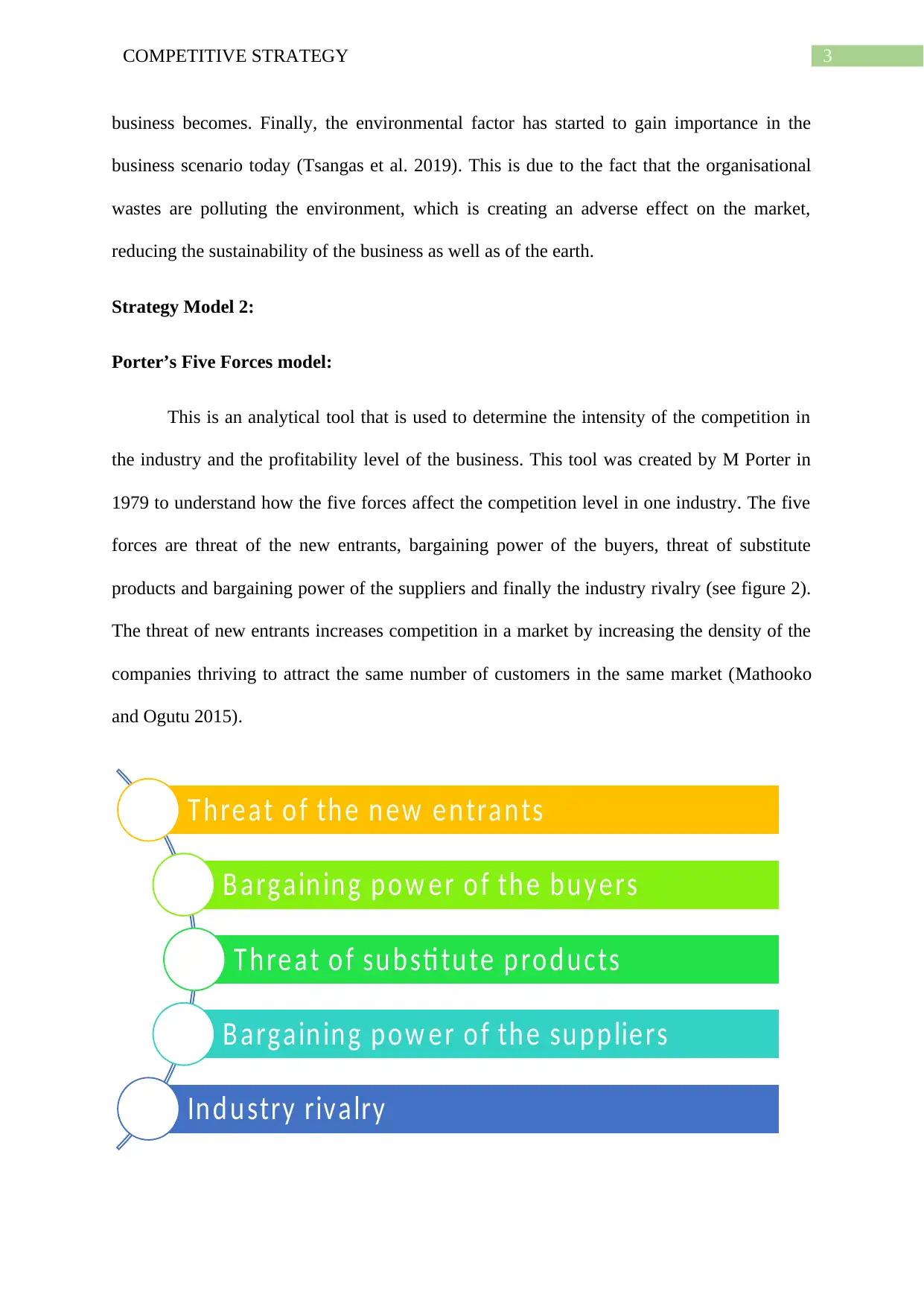
3COMPETITIVE STRATEGY
business becomes. Finally, the environmental factor has started to gain importance in the
business scenario today (Tsangas et al. 2019). This is due to the fact that the organisational
wastes are polluting the environment, which is creating an adverse effect on the market,
reducing the sustainability of the business as well as of the earth.
Strategy Model 2:
Porter’s Five Forces model:
This is an analytical tool that is used to determine the intensity of the competition in
the industry and the profitability level of the business. This tool was created by M Porter in
1979 to understand how the five forces affect the competition level in one industry. The five
forces are threat of the new entrants, bargaining power of the buyers, threat of substitute
products and bargaining power of the suppliers and finally the industry rivalry (see figure 2).
The threat of new entrants increases competition in a market by increasing the density of the
companies thriving to attract the same number of customers in the same market (Mathooko
and Ogutu 2015).
Th rea t o f th e n ew e n tra n ts
B argain in g p o w e r o f th e b u ye rs
T h re a t o f su b sti tu te p ro d u cts
B argain in g p o w e r o f th e su p p liers
In d u stry rivalry
business becomes. Finally, the environmental factor has started to gain importance in the
business scenario today (Tsangas et al. 2019). This is due to the fact that the organisational
wastes are polluting the environment, which is creating an adverse effect on the market,
reducing the sustainability of the business as well as of the earth.
Strategy Model 2:
Porter’s Five Forces model:
This is an analytical tool that is used to determine the intensity of the competition in
the industry and the profitability level of the business. This tool was created by M Porter in
1979 to understand how the five forces affect the competition level in one industry. The five
forces are threat of the new entrants, bargaining power of the buyers, threat of substitute
products and bargaining power of the suppliers and finally the industry rivalry (see figure 2).
The threat of new entrants increases competition in a market by increasing the density of the
companies thriving to attract the same number of customers in the same market (Mathooko
and Ogutu 2015).
Th rea t o f th e n ew e n tra n ts
B argain in g p o w e r o f th e b u ye rs
T h re a t o f su b sti tu te p ro d u cts
B argain in g p o w e r o f th e su p p liers
In d u stry rivalry
Paraphrase This Document
Need a fresh take? Get an instant paraphrase of this document with our AI Paraphraser
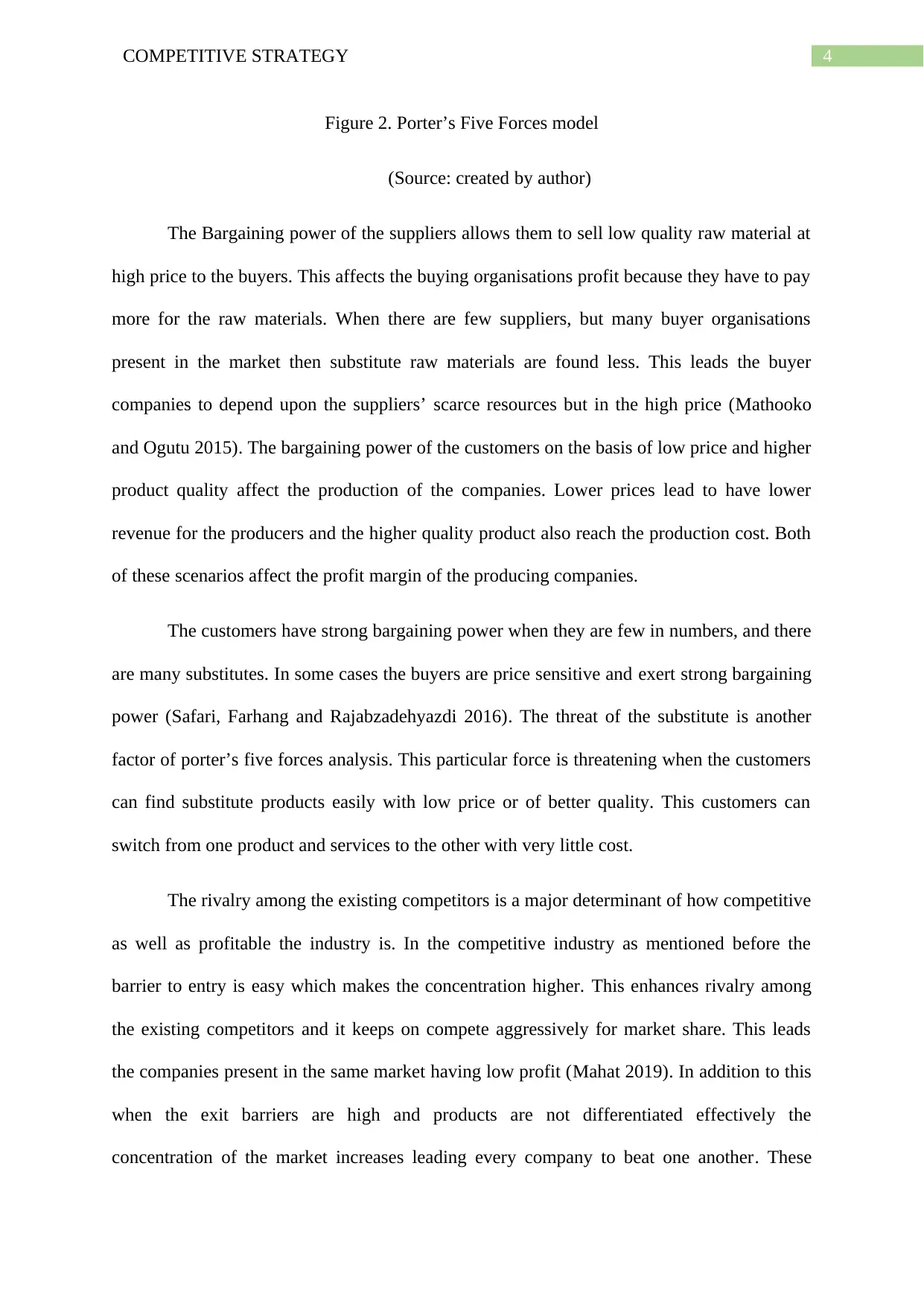
4COMPETITIVE STRATEGY
Figure 2. Porter’s Five Forces model
(Source: created by author)
The Bargaining power of the suppliers allows them to sell low quality raw material at
high price to the buyers. This affects the buying organisations profit because they have to pay
more for the raw materials. When there are few suppliers, but many buyer organisations
present in the market then substitute raw materials are found less. This leads the buyer
companies to depend upon the suppliers’ scarce resources but in the high price (Mathooko
and Ogutu 2015). The bargaining power of the customers on the basis of low price and higher
product quality affect the production of the companies. Lower prices lead to have lower
revenue for the producers and the higher quality product also reach the production cost. Both
of these scenarios affect the profit margin of the producing companies.
The customers have strong bargaining power when they are few in numbers, and there
are many substitutes. In some cases the buyers are price sensitive and exert strong bargaining
power (Safari, Farhang and Rajabzadehyazdi 2016). The threat of the substitute is another
factor of porter’s five forces analysis. This particular force is threatening when the customers
can find substitute products easily with low price or of better quality. This customers can
switch from one product and services to the other with very little cost.
The rivalry among the existing competitors is a major determinant of how competitive
as well as profitable the industry is. In the competitive industry as mentioned before the
barrier to entry is easy which makes the concentration higher. This enhances rivalry among
the existing competitors and it keeps on compete aggressively for market share. This leads
the companies present in the same market having low profit (Mahat 2019). In addition to this
when the exit barriers are high and products are not differentiated effectively the
concentration of the market increases leading every company to beat one another. These
Figure 2. Porter’s Five Forces model
(Source: created by author)
The Bargaining power of the suppliers allows them to sell low quality raw material at
high price to the buyers. This affects the buying organisations profit because they have to pay
more for the raw materials. When there are few suppliers, but many buyer organisations
present in the market then substitute raw materials are found less. This leads the buyer
companies to depend upon the suppliers’ scarce resources but in the high price (Mathooko
and Ogutu 2015). The bargaining power of the customers on the basis of low price and higher
product quality affect the production of the companies. Lower prices lead to have lower
revenue for the producers and the higher quality product also reach the production cost. Both
of these scenarios affect the profit margin of the producing companies.
The customers have strong bargaining power when they are few in numbers, and there
are many substitutes. In some cases the buyers are price sensitive and exert strong bargaining
power (Safari, Farhang and Rajabzadehyazdi 2016). The threat of the substitute is another
factor of porter’s five forces analysis. This particular force is threatening when the customers
can find substitute products easily with low price or of better quality. This customers can
switch from one product and services to the other with very little cost.
The rivalry among the existing competitors is a major determinant of how competitive
as well as profitable the industry is. In the competitive industry as mentioned before the
barrier to entry is easy which makes the concentration higher. This enhances rivalry among
the existing competitors and it keeps on compete aggressively for market share. This leads
the companies present in the same market having low profit (Mahat 2019). In addition to this
when the exit barriers are high and products are not differentiated effectively the
concentration of the market increases leading every company to beat one another. These
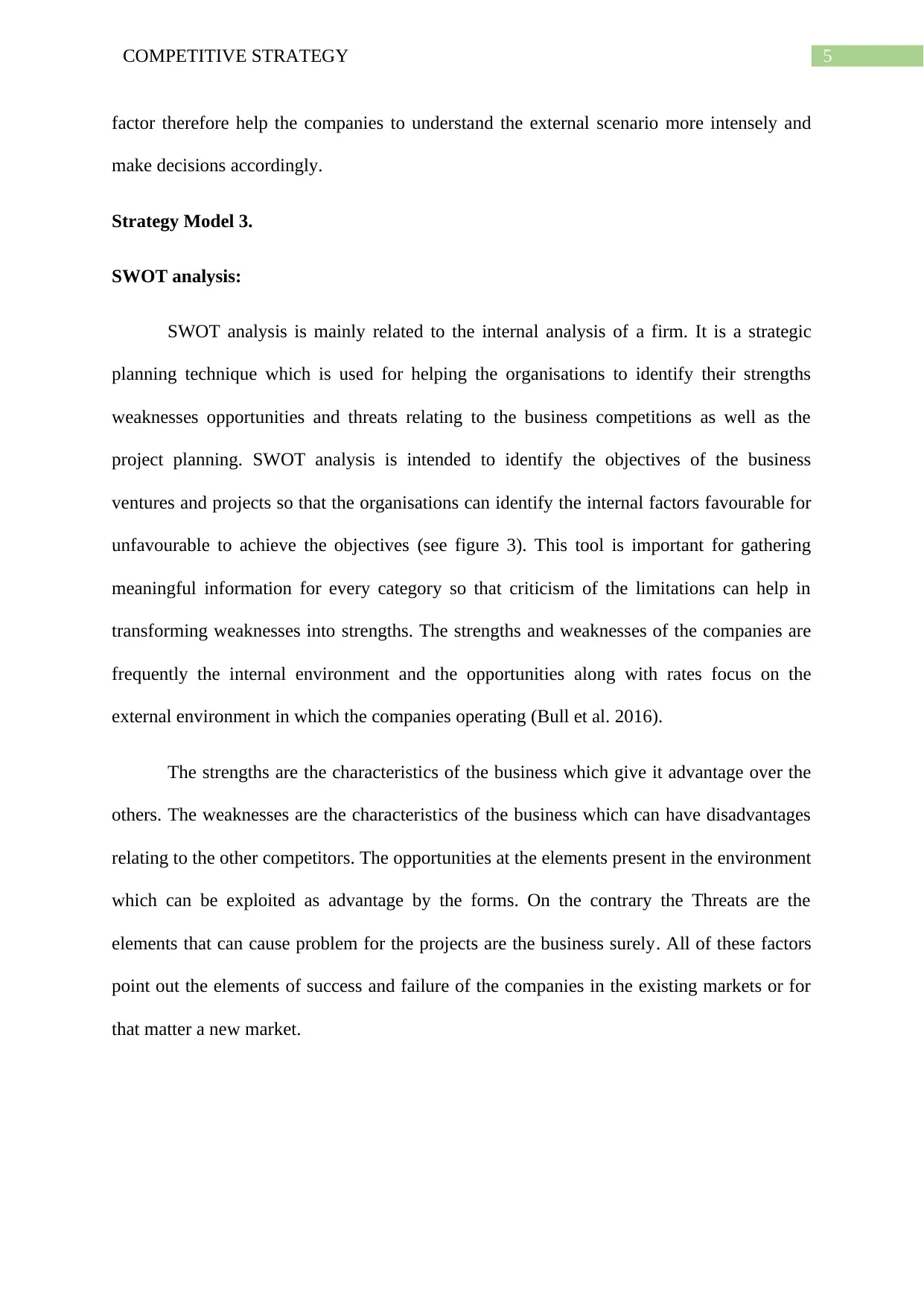
5COMPETITIVE STRATEGY
factor therefore help the companies to understand the external scenario more intensely and
make decisions accordingly.
Strategy Model 3.
SWOT analysis:
SWOT analysis is mainly related to the internal analysis of a firm. It is a strategic
planning technique which is used for helping the organisations to identify their strengths
weaknesses opportunities and threats relating to the business competitions as well as the
project planning. SWOT analysis is intended to identify the objectives of the business
ventures and projects so that the organisations can identify the internal factors favourable for
unfavourable to achieve the objectives (see figure 3). This tool is important for gathering
meaningful information for every category so that criticism of the limitations can help in
transforming weaknesses into strengths. The strengths and weaknesses of the companies are
frequently the internal environment and the opportunities along with rates focus on the
external environment in which the companies operating (Bull et al. 2016).
The strengths are the characteristics of the business which give it advantage over the
others. The weaknesses are the characteristics of the business which can have disadvantages
relating to the other competitors. The opportunities at the elements present in the environment
which can be exploited as advantage by the forms. On the contrary the Threats are the
elements that can cause problem for the projects are the business surely. All of these factors
point out the elements of success and failure of the companies in the existing markets or for
that matter a new market.
factor therefore help the companies to understand the external scenario more intensely and
make decisions accordingly.
Strategy Model 3.
SWOT analysis:
SWOT analysis is mainly related to the internal analysis of a firm. It is a strategic
planning technique which is used for helping the organisations to identify their strengths
weaknesses opportunities and threats relating to the business competitions as well as the
project planning. SWOT analysis is intended to identify the objectives of the business
ventures and projects so that the organisations can identify the internal factors favourable for
unfavourable to achieve the objectives (see figure 3). This tool is important for gathering
meaningful information for every category so that criticism of the limitations can help in
transforming weaknesses into strengths. The strengths and weaknesses of the companies are
frequently the internal environment and the opportunities along with rates focus on the
external environment in which the companies operating (Bull et al. 2016).
The strengths are the characteristics of the business which give it advantage over the
others. The weaknesses are the characteristics of the business which can have disadvantages
relating to the other competitors. The opportunities at the elements present in the environment
which can be exploited as advantage by the forms. On the contrary the Threats are the
elements that can cause problem for the projects are the business surely. All of these factors
point out the elements of success and failure of the companies in the existing markets or for
that matter a new market.
You're viewing a preview
Unlock full access by subscribing today!
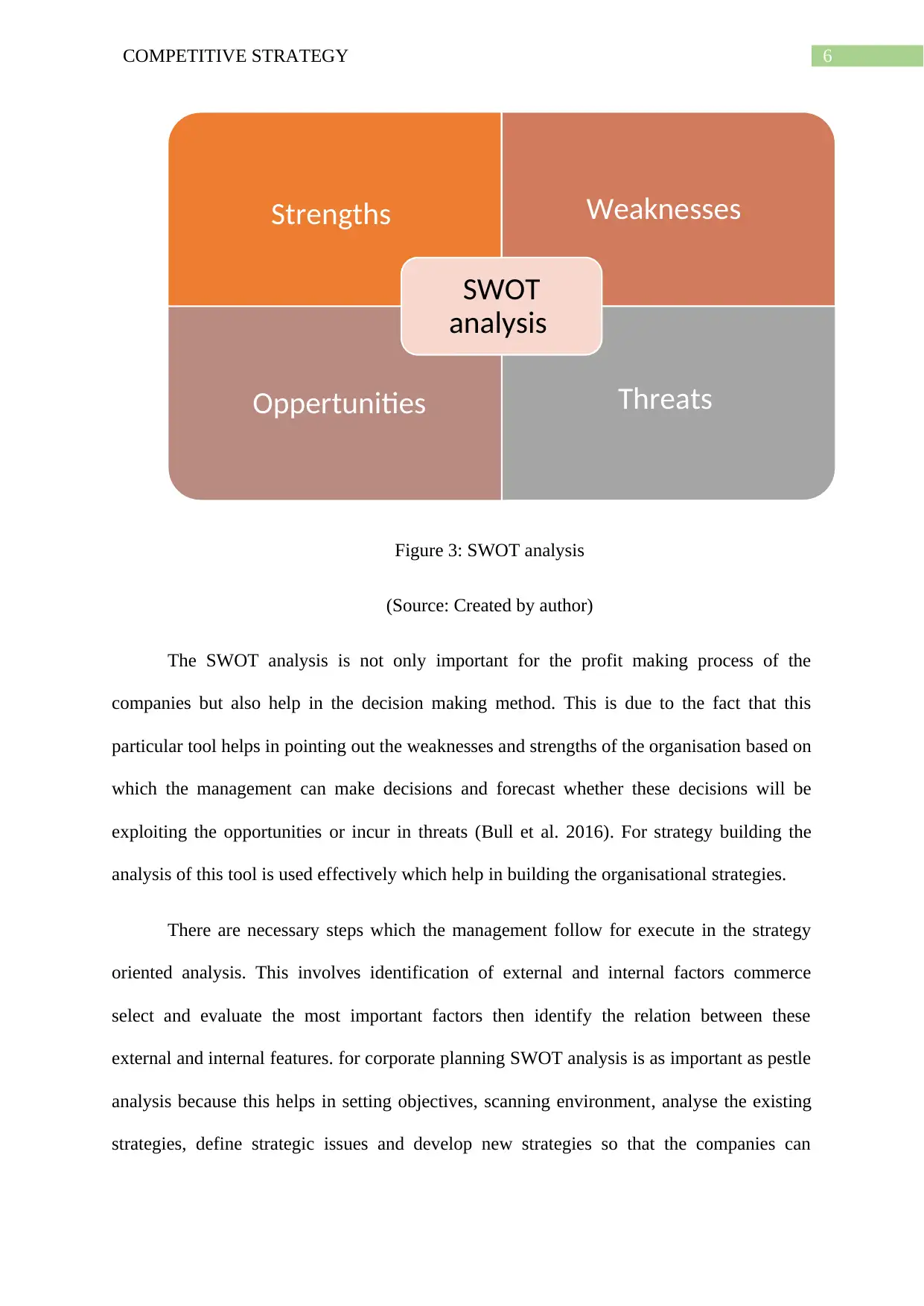
6COMPETITIVE STRATEGY
Figure 3: SWOT analysis
(Source: Created by author)
The SWOT analysis is not only important for the profit making process of the
companies but also help in the decision making method. This is due to the fact that this
particular tool helps in pointing out the weaknesses and strengths of the organisation based on
which the management can make decisions and forecast whether these decisions will be
exploiting the opportunities or incur in threats (Bull et al. 2016). For strategy building the
analysis of this tool is used effectively which help in building the organisational strategies.
There are necessary steps which the management follow for execute in the strategy
oriented analysis. This involves identification of external and internal factors commerce
select and evaluate the most important factors then identify the relation between these
external and internal features. for corporate planning SWOT analysis is as important as pestle
analysis because this helps in setting objectives, scanning environment, analyse the existing
strategies, define strategic issues and develop new strategies so that the companies can
Strengths Weaknesses
Oppertunities Threats
SWOT
analysis
Figure 3: SWOT analysis
(Source: Created by author)
The SWOT analysis is not only important for the profit making process of the
companies but also help in the decision making method. This is due to the fact that this
particular tool helps in pointing out the weaknesses and strengths of the organisation based on
which the management can make decisions and forecast whether these decisions will be
exploiting the opportunities or incur in threats (Bull et al. 2016). For strategy building the
analysis of this tool is used effectively which help in building the organisational strategies.
There are necessary steps which the management follow for execute in the strategy
oriented analysis. This involves identification of external and internal factors commerce
select and evaluate the most important factors then identify the relation between these
external and internal features. for corporate planning SWOT analysis is as important as pestle
analysis because this helps in setting objectives, scanning environment, analyse the existing
strategies, define strategic issues and develop new strategies so that the companies can
Strengths Weaknesses
Oppertunities Threats
SWOT
analysis
Paraphrase This Document
Need a fresh take? Get an instant paraphrase of this document with our AI Paraphraser
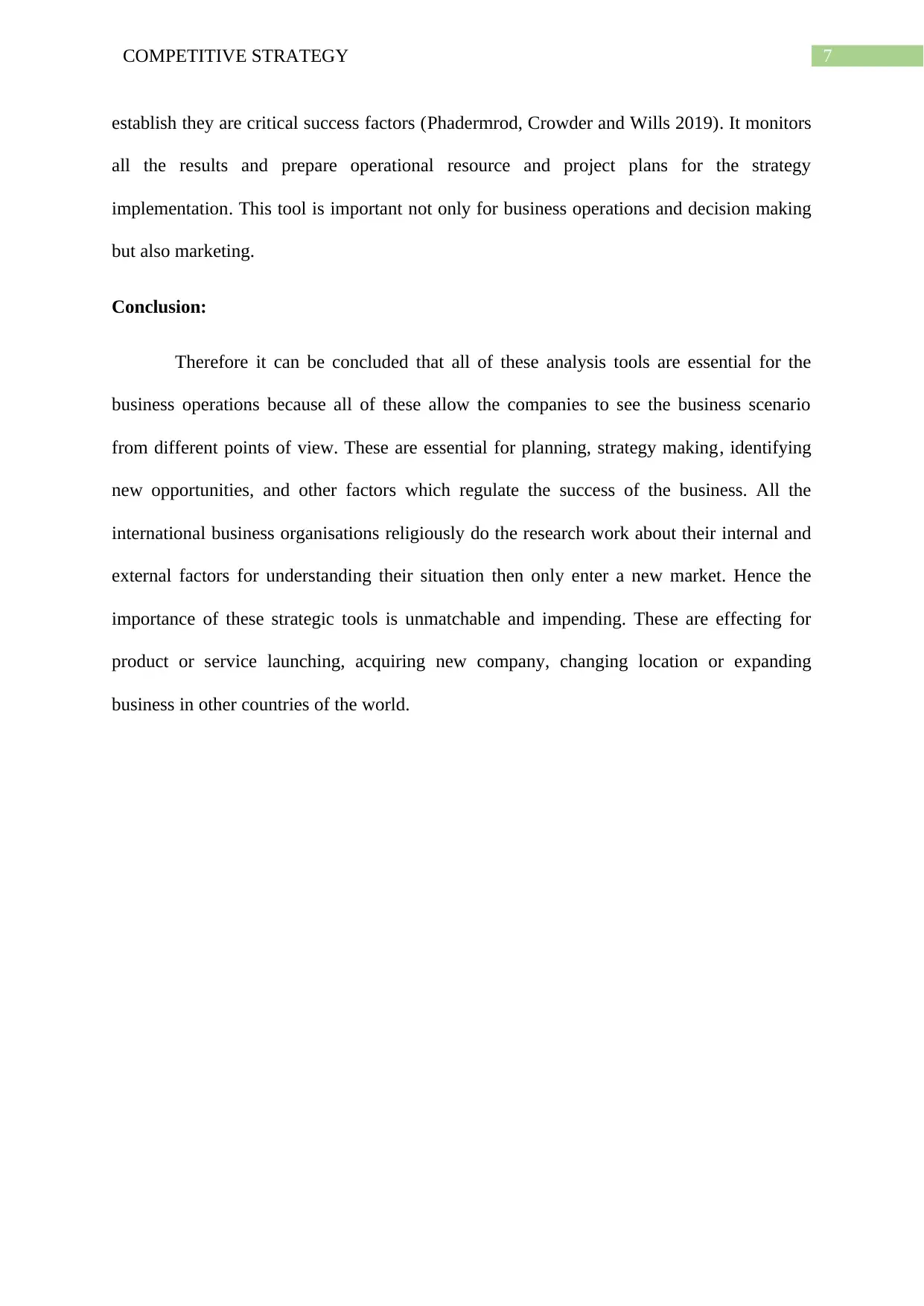
7COMPETITIVE STRATEGY
establish they are critical success factors (Phadermrod, Crowder and Wills 2019). It monitors
all the results and prepare operational resource and project plans for the strategy
implementation. This tool is important not only for business operations and decision making
but also marketing.
Conclusion:
Therefore it can be concluded that all of these analysis tools are essential for the
business operations because all of these allow the companies to see the business scenario
from different points of view. These are essential for planning, strategy making, identifying
new opportunities, and other factors which regulate the success of the business. All the
international business organisations religiously do the research work about their internal and
external factors for understanding their situation then only enter a new market. Hence the
importance of these strategic tools is unmatchable and impending. These are effecting for
product or service launching, acquiring new company, changing location or expanding
business in other countries of the world.
establish they are critical success factors (Phadermrod, Crowder and Wills 2019). It monitors
all the results and prepare operational resource and project plans for the strategy
implementation. This tool is important not only for business operations and decision making
but also marketing.
Conclusion:
Therefore it can be concluded that all of these analysis tools are essential for the
business operations because all of these allow the companies to see the business scenario
from different points of view. These are essential for planning, strategy making, identifying
new opportunities, and other factors which regulate the success of the business. All the
international business organisations religiously do the research work about their internal and
external factors for understanding their situation then only enter a new market. Hence the
importance of these strategic tools is unmatchable and impending. These are effecting for
product or service launching, acquiring new company, changing location or expanding
business in other countries of the world.
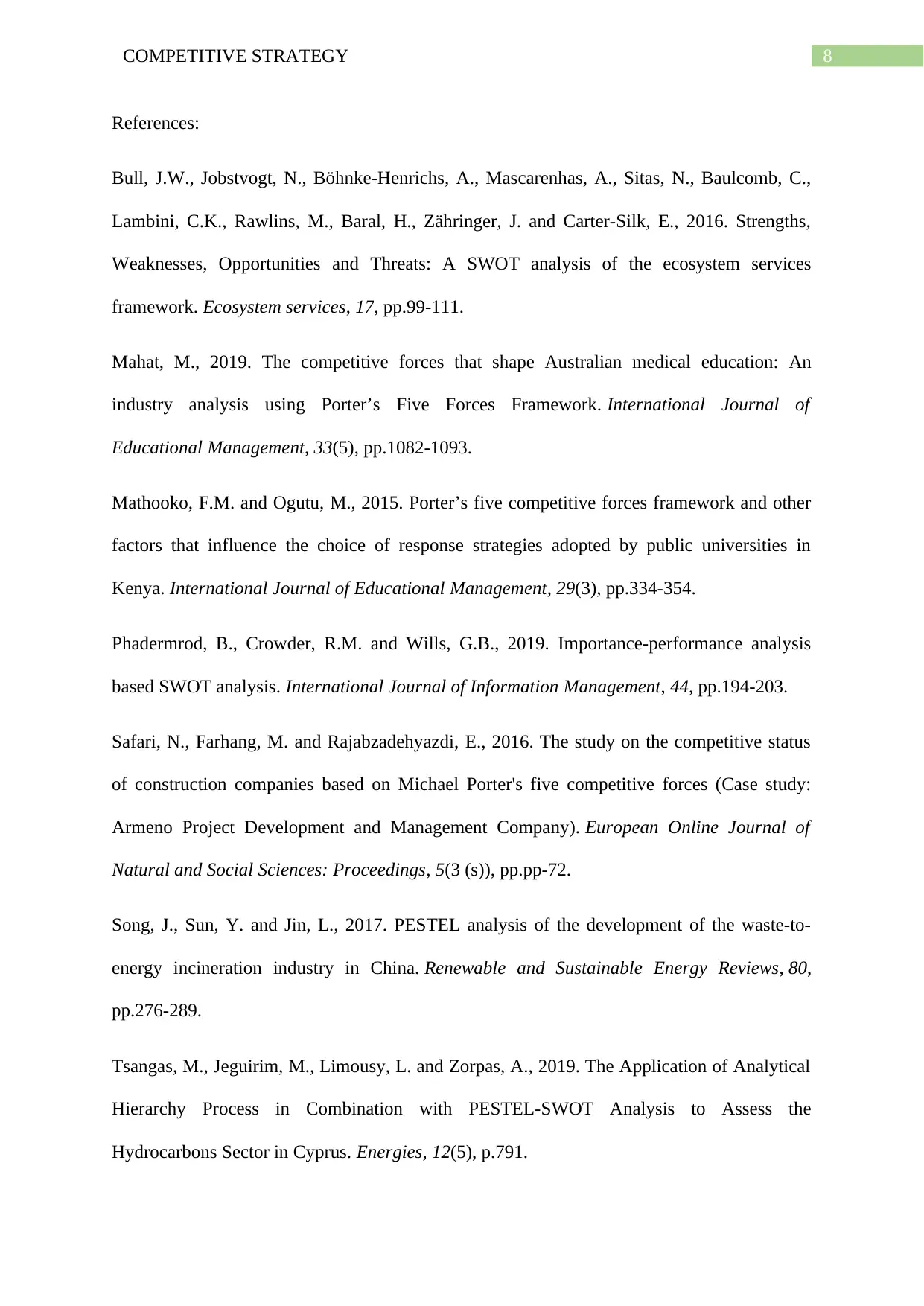
8COMPETITIVE STRATEGY
References:
Bull, J.W., Jobstvogt, N., Böhnke-Henrichs, A., Mascarenhas, A., Sitas, N., Baulcomb, C.,
Lambini, C.K., Rawlins, M., Baral, H., Zähringer, J. and Carter-Silk, E., 2016. Strengths,
Weaknesses, Opportunities and Threats: A SWOT analysis of the ecosystem services
framework. Ecosystem services, 17, pp.99-111.
Mahat, M., 2019. The competitive forces that shape Australian medical education: An
industry analysis using Porter’s Five Forces Framework. International Journal of
Educational Management, 33(5), pp.1082-1093.
Mathooko, F.M. and Ogutu, M., 2015. Porter’s five competitive forces framework and other
factors that influence the choice of response strategies adopted by public universities in
Kenya. International Journal of Educational Management, 29(3), pp.334-354.
Phadermrod, B., Crowder, R.M. and Wills, G.B., 2019. Importance-performance analysis
based SWOT analysis. International Journal of Information Management, 44, pp.194-203.
Safari, N., Farhang, M. and Rajabzadehyazdi, E., 2016. The study on the competitive status
of construction companies based on Michael Porter's five competitive forces (Case study:
Armeno Project Development and Management Company). European Online Journal of
Natural and Social Sciences: Proceedings, 5(3 (s)), pp.pp-72.
Song, J., Sun, Y. and Jin, L., 2017. PESTEL analysis of the development of the waste-to-
energy incineration industry in China. Renewable and Sustainable Energy Reviews, 80,
pp.276-289.
Tsangas, M., Jeguirim, M., Limousy, L. and Zorpas, A., 2019. The Application of Analytical
Hierarchy Process in Combination with PESTEL-SWOT Analysis to Assess the
Hydrocarbons Sector in Cyprus. Energies, 12(5), p.791.
References:
Bull, J.W., Jobstvogt, N., Böhnke-Henrichs, A., Mascarenhas, A., Sitas, N., Baulcomb, C.,
Lambini, C.K., Rawlins, M., Baral, H., Zähringer, J. and Carter-Silk, E., 2016. Strengths,
Weaknesses, Opportunities and Threats: A SWOT analysis of the ecosystem services
framework. Ecosystem services, 17, pp.99-111.
Mahat, M., 2019. The competitive forces that shape Australian medical education: An
industry analysis using Porter’s Five Forces Framework. International Journal of
Educational Management, 33(5), pp.1082-1093.
Mathooko, F.M. and Ogutu, M., 2015. Porter’s five competitive forces framework and other
factors that influence the choice of response strategies adopted by public universities in
Kenya. International Journal of Educational Management, 29(3), pp.334-354.
Phadermrod, B., Crowder, R.M. and Wills, G.B., 2019. Importance-performance analysis
based SWOT analysis. International Journal of Information Management, 44, pp.194-203.
Safari, N., Farhang, M. and Rajabzadehyazdi, E., 2016. The study on the competitive status
of construction companies based on Michael Porter's five competitive forces (Case study:
Armeno Project Development and Management Company). European Online Journal of
Natural and Social Sciences: Proceedings, 5(3 (s)), pp.pp-72.
Song, J., Sun, Y. and Jin, L., 2017. PESTEL analysis of the development of the waste-to-
energy incineration industry in China. Renewable and Sustainable Energy Reviews, 80,
pp.276-289.
Tsangas, M., Jeguirim, M., Limousy, L. and Zorpas, A., 2019. The Application of Analytical
Hierarchy Process in Combination with PESTEL-SWOT Analysis to Assess the
Hydrocarbons Sector in Cyprus. Energies, 12(5), p.791.
You're viewing a preview
Unlock full access by subscribing today!
1 out of 9
Related Documents
Your All-in-One AI-Powered Toolkit for Academic Success.
+13062052269
info@desklib.com
Available 24*7 on WhatsApp / Email
![[object Object]](/_next/static/media/star-bottom.7253800d.svg)
Unlock your academic potential
© 2024 | Zucol Services PVT LTD | All rights reserved.





